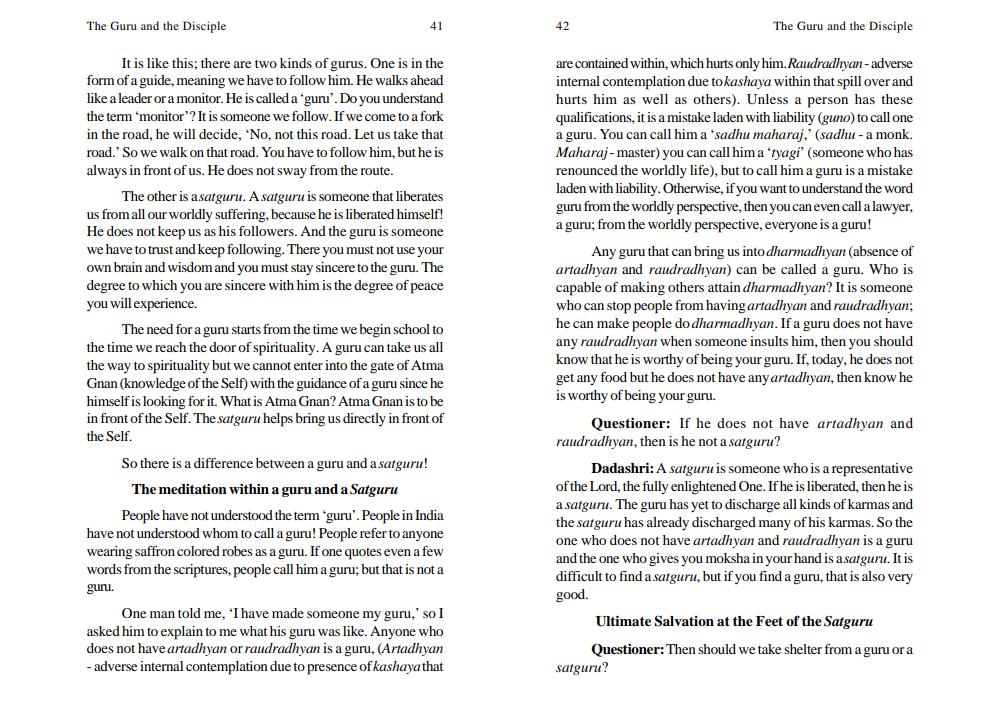________________
The Guru and the Disciple
41
It is like this; there are two kinds of gurus. One is in the form of a guide, meaning we have to follow him. He walks ahead like a leader or a monitor. He is called a 'guru'. Do you understand the term 'monitor'? It is someone we follow. If we come to a fork in the road, he will decide, 'No, not this road. Let us take that road.' So we walk on that road. You have to follow him, but he is always in front of us. He does not sway from the route.
The other is a satguru. A satguru is someone that liberates us from all our worldly suffering, because he is liberated himself! He does not keep us as his followers. And the guru is someone we have to trust and keep following. There you must not use your own brain and wisdom and you must stay sincere to the guru. The degree to which you are sincere with him is the degree of peace you will experience.
The need for a guru starts from the time we begin school to the time we reach the door of spirituality. A guru can take us all the way to spirituality but we cannot enter into the gate of Atma Gnan (knowledge of the Self) with the guidance of a guru since he himself is looking for it. What is Atma Gnan? Atma Gnan is to be in front of the Self. The satguru helps bring us directly in front of the Self.
So there is a difference between a guru and a satguru! The meditation within a guru and a Satguru
People have not understood the term 'guru'. People in India have not understood whom to call a guru! People refer to anyone wearing saffron colored robes as a guru. If one quotes even a few words from the scriptures, people call him a guru; but that is not a guru.
One man told me, 'I have made someone my guru,' so I asked him to explain to me what his guru was like. Anyone who does not have artadhyan or raudradhyan is a guru, (Artadhyan - adverse internal contemplation due to presence of kashaya that
The Guru and the Disciple
are contained within, which hurts only him. Raudradhyan - adverse internal contemplation due to kashaya within that spill over and hurts him as well as others). Unless a person has these qualifications, it is a mistake laden with liability (guno) to call one a guru. You can call him a 'sadhu maharaj,' (sadhu - a monk. Maharaj-master) you can call him a 'tyagi" (someone who has renounced the worldly life), but to call him a guru is a mistake laden with liability. Otherwise, if you want to understand the word guru from the worldly perspective, then you can even call a lawyer, a guru; from the worldly perspective, everyone is a guru!
42
Any guru that can bring us into dharmadhyan (absence of artadhyan and raudradhyan) can be called a guru. Who is capable of making others attain dharmadhyan? It is someone who can stop people from having artadhyan and raudradhyan; he can make people do dharmadhyan. If a guru does not have any raudradhyan when someone insults him, then you should know that he is worthy of being your guru. If, today, he does not get any food but he does not have any artadhyan, then know he is worthy of being your guru.
Questioner: If he does not have artadhyan and raudradhyan, then is he not a satguru?
Dadashri: A satguru is someone who is a representative of the Lord, the fully enlightened One. If he is liberated, then he is a satguru. The guru has yet to discharge all kinds of karmas and the satguru has already discharged many of his karmas. So the one who does not have artadhyan and raudradhyan is a guru and the one who gives you moksha in your hand is a satguru. It is difficult to find a satguru, but if you find a guru, that is also very good.
Ultimate Salvation at the Feet of the Satguru
Questioner: Then should we take shelter from a guru or a
satguru?




